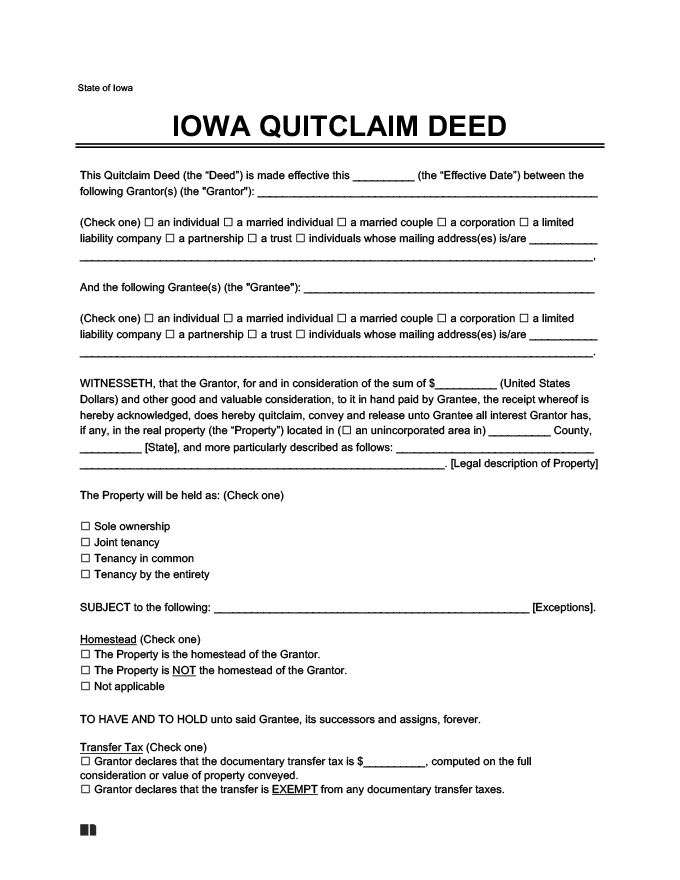An Iowa quitclaim deed is a legal agreement between a property owner, also called the grantor, and a recipient, or grantee. A quitclaim deed allows the grantor to transfer real estate property to the grantee without a guarantee of title or ownership.
A person who owns property in Iowa may use a quitclaim deed under the following circumstances:
- To transfer properties between former spouses in divorce proceedings
- To convey property between family members for little or no consideration
- To gift real estate to a close family member
- To transfer real property to a business owned by the grantor
- To correct or modify an existing deed
- To add or remove someone from the title
Legal Framework
State laws create a legal framework for the contents, formats, uses, and requirements for quitclaim deeds. Iowa Code § 558 establishes how deeds can convey property between a grantor and grantee.
Legal Description
- § 331.606B states that any deed or conveyance must include a legal description of the property being transferred. You can usually find a valid legal description on the existing deed for the property. Per § 354, this may include the following measurement methods:
- Subdivision name or title
- Lot number
- Parcel designation and reference
- Document reference of the plat
- Section, township, and range number
- Metes and bounds
Signing
- § 558.20 requires any deed, conveyance, or other real estate transfer document to be signed and notarized consistent with § 9B.
Per § 561.13, a deed that transfers homestead property must be signed by the owner’s spouse if they are married.
Terminology
- § 558.19 provides terminology for quitclaim deeds. You can use other terminology, but the deed must state that the grantor “quitclaims” rather than “conveys” the property. In addition, it should indicate that the property is transferred without warranty.
Additional Documents
Per Iowa Admin. Code R. 701-79.5, a real estate transfer declaration of value form must accompany your quitclaim deed when you submit it for recording. Depending on the property details and location, you may also need to file a groundwater hazard statement, per § 558.69.
Filing
To be considered valid, a quitclaim deed must be filed with the Office of the County Recorder in the county where the real estate is located, as per § 558.41.
Validity Requirements
To ensure ease of filing and document consistency, § 331.606B establishes the following formatting requirements for all recorded documents:
- Each document must be on white paper of at least 20-pound weight with no watermarks or visible inclusions
- Text within the document must be clear and readable when reproduced
- All signatures must be in dark blue or black ink
- The first page of each document must have a margin of 3 in.
- All other margins must be a minimum of ¾ in.
- Each document must be typed or printed with a minimum 10-point text with no more than 20 characters and pages per inch.
- Documents should be presented on individual pages not permanently bound or in continuous form.
Your county recorder may have different formatting and submission requirements. To avoid complications, contact the county recorder’s office in the county where the property is for clarification.
Content Requirements
Quitclaim deeds presented for recording must include the following details on the first page:
- Name, address, and phone number of the person who prepared the deed
- Grantee’s full name and mailing address
- The return address for the registered deed
- Title of the quitclaim deed
- All grantor and grantee names
- Any additional address required by statute
- The property’s legal description and parcel identification number
Per § 331.606A, documents cannot include certain personally identifiable information, such as a social security number or bank account information.
Quitclaim Deeds vs. Other Property Transfer Methods
| Quitclaim Deed | Transfers real property from the seller, or grantee, to the recipient, or grantor, without guarantee of title or ownership by the grantor. The grantor is not liable if title or ownership issues arise. |
| General Warranty Deed | Transfers property with a full warranty for a free and clear title. The grantor carries full liability for any title defects or encumbrances related to the real property. |
| Special Warranty Deed | Transfers property with a title warranty limited to the time the grantor had control of the property. The grantor carries responsibility for title defects that arose during their ownership, but not before. |
| Title Insurance | Grantees who receive property through a quitclaim deed can mitigate their financial responsibility with title insurance. For a premium fee, the insurance company will help cover losses associated with title defects or encumbrances that may arise. |
| Life Estate Deeds | Life estate deeds allow the grantor to convey ownership to a new owner while retaining the right to live in the property until their death. Similarly, a transfer on death (TOD) deed transfers ownership of the property to a beneficiary upon the owner’s death. |
| Co-Ownership | § 557.15 establishes co-ownership through tenancy in common or joint tenancy, which allows a co-owner’s interest in a property to automatically transfer to the other owners upon their death. |
